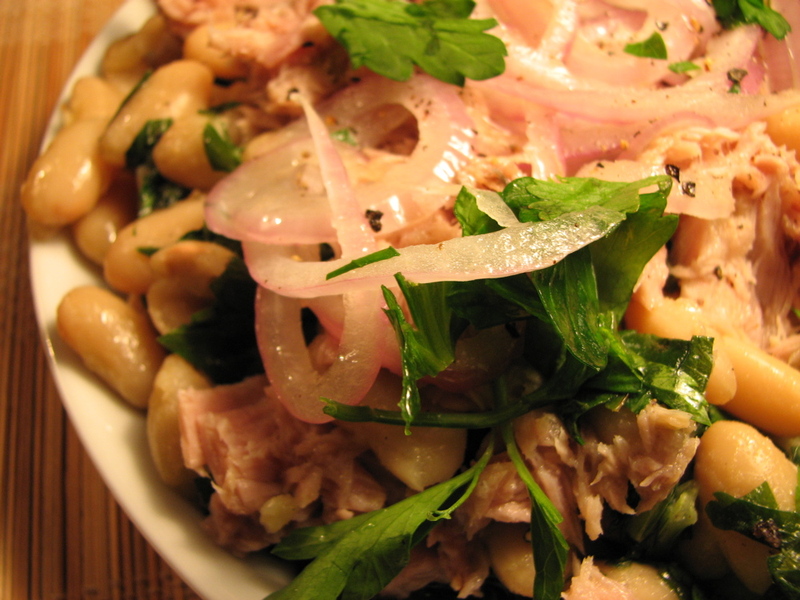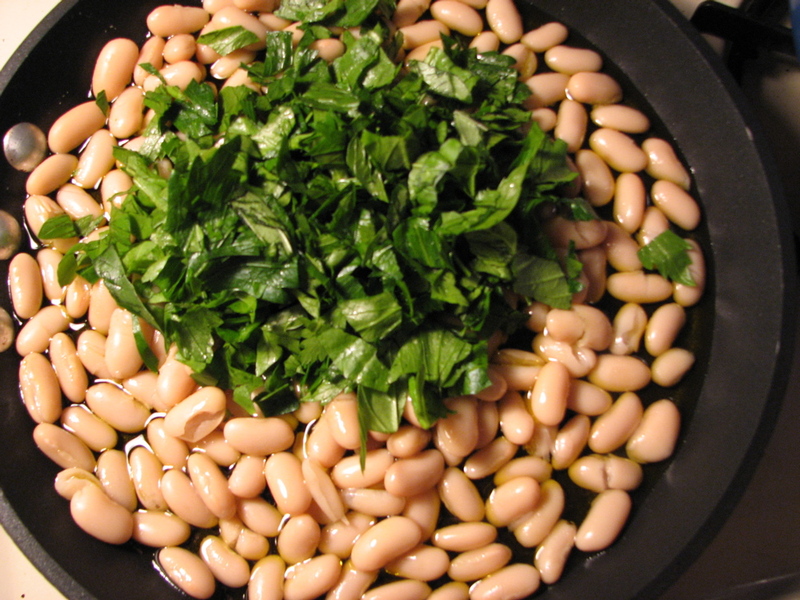White Bean Herb Salad with Tuna
 Lately I’ve been going to restaurants and leaving with ideas for what to cook at home. A previous post , a salad of roasted squash and dandelion greens, was inspired by the restaurant 360 , an unpretentious little spot where you can eat for $25 and the wine list, which emphasises organic, is very reasonable. My version of the squash salad wasn’t nearly as good--I didn’t have the wonderful, meaty thick-cut bacon that the restaurant had; I didn’t have the seasonings just right; the squash wasn’t as sweet and carmelized as I remember. But it was still reminiscent and it was very satisfying. Sometimes one goes to a restaurant and leave saying “Well, I feel like I could have made that better in my own kitchen, for far cheaper and in the comfort of my own home.” As I’ve gotten to be a better cook, learned some intuition and how to use all five senses to really feel what’s going on with the food I’m cooking, I have often run into this problem. Though I can’t cook something things as spot-on perfectly as a trained chef, I have reached a point where I can get pretty close. However: I keep going to restaurants. I keep paying twice or three times as much for the same ingredients, putting myself in the hands of a stranger and leaving my own home, and getting fed. When you think about it very basically, the whole concept of restaurants is rather strange: you enter a dwelling belonging to someone else, someone you don’t know and won’t likely meet, and pay them money to make your dinner. What compels people? Is it convenience? Lack of ambition or skill to cook for one’s self? The camaraderie of dining with friends without worrying about the actual cooking? For me, it’s become inspiration. I visit New York’s restaurants because there are trained people in them making something I’d never dream up myself, something robust and inspired and artful. I go for the experience, yes, certainly, for the ambience with friends and the pleasure and the chance to relax; but also I go for the almost intellectual exercise of seeing what can be done with food. This time, it was actually a different experience: I ordered a salad with cannellini beans and tuna, and ended up being pretty much disappointed with the meal. The beans were mushy and lacked definition, and most importantly were tasteless; the red onion was raw and too harsh; the tuna was simple out of a can. But halfway through the meal, I realized that this is going to solve the problem of how to use the ten cans or so of beans which have been collecting in my cabinets, along with the overstock of cans of tuna, both of which I can’t resist buying when on sale because I know they can sit forever in there, waiting until I’m ready. I don’t know if I’ve got this salad just right yet. There is a similar recipe in Pierre Franey’s The New York Time 60-Minute Gourmet , which is a fabulous book full of actual gourmet recipes that can be prepared in 60 minutes (this includes main course and sides) without turning to the pre-prepared Rachel Ray-style approach--Franey is a classically trained chef. He claims that eat canned tuna is perfectly acceptable (especially with “a good deal of relish”) and claims to have eaten it canned with cooked white beans more than once during trips through Italy. His version uses dried oregano, scallions, and lemon juice, while I made mine with random herbs in the fridge. This is a great option for lunch, easy to throw together, acceptable in what Franey deems “emergency occasions,” and, if executed correctly, a pretty inspired combination. White Bean Herb Salad with Tuna
Lately I’ve been going to restaurants and leaving with ideas for what to cook at home. A previous post , a salad of roasted squash and dandelion greens, was inspired by the restaurant 360 , an unpretentious little spot where you can eat for $25 and the wine list, which emphasises organic, is very reasonable. My version of the squash salad wasn’t nearly as good--I didn’t have the wonderful, meaty thick-cut bacon that the restaurant had; I didn’t have the seasonings just right; the squash wasn’t as sweet and carmelized as I remember. But it was still reminiscent and it was very satisfying. Sometimes one goes to a restaurant and leave saying “Well, I feel like I could have made that better in my own kitchen, for far cheaper and in the comfort of my own home.” As I’ve gotten to be a better cook, learned some intuition and how to use all five senses to really feel what’s going on with the food I’m cooking, I have often run into this problem. Though I can’t cook something things as spot-on perfectly as a trained chef, I have reached a point where I can get pretty close. However: I keep going to restaurants. I keep paying twice or three times as much for the same ingredients, putting myself in the hands of a stranger and leaving my own home, and getting fed. When you think about it very basically, the whole concept of restaurants is rather strange: you enter a dwelling belonging to someone else, someone you don’t know and won’t likely meet, and pay them money to make your dinner. What compels people? Is it convenience? Lack of ambition or skill to cook for one’s self? The camaraderie of dining with friends without worrying about the actual cooking? For me, it’s become inspiration. I visit New York’s restaurants because there are trained people in them making something I’d never dream up myself, something robust and inspired and artful. I go for the experience, yes, certainly, for the ambience with friends and the pleasure and the chance to relax; but also I go for the almost intellectual exercise of seeing what can be done with food. This time, it was actually a different experience: I ordered a salad with cannellini beans and tuna, and ended up being pretty much disappointed with the meal. The beans were mushy and lacked definition, and most importantly were tasteless; the red onion was raw and too harsh; the tuna was simple out of a can. But halfway through the meal, I realized that this is going to solve the problem of how to use the ten cans or so of beans which have been collecting in my cabinets, along with the overstock of cans of tuna, both of which I can’t resist buying when on sale because I know they can sit forever in there, waiting until I’m ready. I don’t know if I’ve got this salad just right yet. There is a similar recipe in Pierre Franey’s The New York Time 60-Minute Gourmet , which is a fabulous book full of actual gourmet recipes that can be prepared in 60 minutes (this includes main course and sides) without turning to the pre-prepared Rachel Ray-style approach--Franey is a classically trained chef. He claims that eat canned tuna is perfectly acceptable (especially with “a good deal of relish”) and claims to have eaten it canned with cooked white beans more than once during trips through Italy. His version uses dried oregano, scallions, and lemon juice, while I made mine with random herbs in the fridge. This is a great option for lunch, easy to throw together, acceptable in what Franey deems “emergency occasions,” and, if executed correctly, a pretty inspired combination. White Bean Herb Salad with Tuna 
- One can tuna
- One can cannellini beans
- chopped herbs (parsely, basil, dandelion greens, arugala, etc., whatever) or try scallions
- a clove minced garlic
- 1/2 tablespoon red wine vinegar
- lemon juice (optional)
- 1/8 cup good olive oil
- salt and pepper
- 1/2 small red onion (optional)
Serves 1. Drain the canned beans in a colander, rinsing off the liquid they're stored in. In a skillet, put the heat on low . Add the oil red onion if using, cooking gently until only a little soft. Remove onion and reserve, then add garlic to the skillet and let the garlic cook very briefly until just fragrant. Then add the beans.  Toss in your chopped herbs and/or scallions and mix together with the beans and oil, letting the whole thing warm through. Transfer to a serving/mixing bowl, add vinegar and lemon juice if using, salt and pepper. Drain tuna and flake over the top, toss if desired, then garnish with red onion.
Toss in your chopped herbs and/or scallions and mix together with the beans and oil, letting the whole thing warm through. Transfer to a serving/mixing bowl, add vinegar and lemon juice if using, salt and pepper. Drain tuna and flake over the top, toss if desired, then garnish with red onion.


Comments:
Blog Comments powered by Disqus.